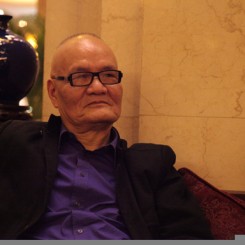After exhibiting work in Vancouver at Art Beatus, the shows were promoted in further exhibitions abroad. The Foundation covered travel expenses and sponsored artists’ involvement in international biennales. At the time, art galleries based in China were not on Basel’s invitation list. However, from 1998, the Annie Wong Art Foundation was invited to show the work of Chinese artists such as Huang Yongping, Chen Zhen, Xu Bing, Wang Jianwei, Yue Minjun, Zheng Guogu, Gu Wenda, Shen Yuan, and many others. As Zheng recalls, “We sponsored Cai Guo-Qiang to go to the 48th Venice Biennale, the year he did ‘Venice’s Rent Collection Courtyard’ and won [the Golden Lion Award. We sponsored Chen Zhen’s major exhibition in Israel. His installation was so successful that he was invited to Venice Biennale in 1999.”
Though based the whole time in Vancouver, the Annie Wong Art Foundation was also involved in the early years of the Shanghai Biennale. In 1998, the Directors of the Shanghai Art Museum approached the Annie Wong Art Foundation for assistance. They wanted to develop the Biennale into an international show and they needed help making sense of the international art scene. The Foundation stepped in as a co-organizer from 1998 and donated half a million Renminbi to the Biennale. They also recommended Hou Hanru as the co-curator, for the third Shanghai Biennale (2000), who started to invite and attract international artists.
As well as helping Chinese artists gain international exposure abroad, at the end of 2000, the Foundation toured well-known Western curators (such as Okwui Enwezor, now director Haus der Kunst in Munich, Chris Dercon, the new Director of Tate Modern, and Lynne Cooke, curator-at-large for DIA Foundation, New York, and chief-curator for the Museo Reina Sofia, Madrid) around art studios in Beijing, Shanghai, Hangzhou, Guangzhou, Taipei and Hong Kong. “Yang Fudong was ‘discovered’ by those curators. He and other artists were introduced to Europe and the United States.”
Shaking his head, Zheng pauses and adds, “Those were very busy years!” Eventually, he and Wong were ready to move on to other projects. By that time contemporary Chinese art had made its international debut, the art market was heating up, and commercial sponsors (for better or for worse) were then ready to step in and take the place of the Foundation in funding the Shanghai Biennale.
Art Beatus and the Annie Wong Art Foundation continue to support and exhibit Chinese contemporary art from locations in Vancouver and Hong Kong. Zheng helped set-up and remains actively involved with Vancouver’s Centre A, a pivotal Vancouver institution devoted to Asian Art. He also worked with Ken Lum, contemporary artist and academic, to establish Yishu: Journal of Contemporary Chinese Art and is its Managing Editor.
After enthusiastically promoting Chinese contemporary art from Vancouver for 20 years, Zheng’s views are now much more cautious and his role as promoter has shifted to that of critic. From this new vantage point, he continues to see Vancouver as a city with an important role to play in the future of Chinese contemporary art.



